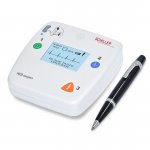
Everything Echocardiography Offers - at 4 559 Meters Above Sea Level
It has long been known that hypoxia at high altitudes leads to an increase of pulmonaryarterial pressure. For sensitive persons, one crucial factor for the development of HAPE is the overwhelming rise in pressure in the pulmonary circulation. Using right heart catheterization average pulmonary-arterial pressures of 60 mmHg were encountered in earlier studies of HAPE patients. A pressure increase…

























